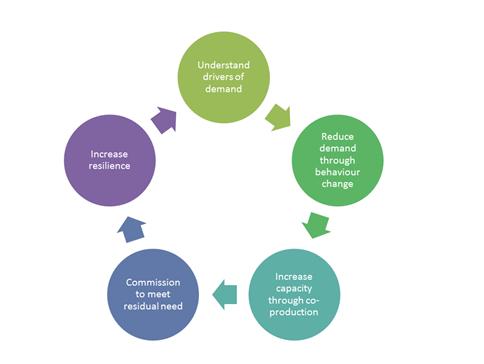Catherine Staite responds to Local Government Chronicle’s anonymous ‘Insider’ columnist about the ‘jaws of doom’ and INLOGOV’s New Model of Public Services.
Dear Secret Chief Executive
I’m so sorry to hear you are having such a miserable time. Leading in difficult times really does take it out of you. However, this isn’t like you – so buck up. If you give way to despair, how will your staff cope?
You describe an impossible conundrum. You have rising demands and falling resources – otherwise known as the ‘jaws of doom’. You know that the solutions of the past aren’t going to solve the problems of the present or the future. You need some new thinking. The good news is that there is a lot of it available and much of it is pretty much free.
At INLOGOV, we’ve developed a model that you can use to re-think the way you meet your challenges. We’ve tested the model with many of your chief executive colleagues who’ve shared their time, insights and inspiration with us so we can offer something useful to you. Our book ‘Making sense of the future: do we need a new model of public services?’ is available to download on our website. There are chapters on building better relationships, behaviour change and demand management, co-production and risk and resilience. Chapters on collaboration and integration and on income generation will be added shortly. The book is a gift from us to you.
In brief – here’s some of our thinking. You operate in a whole system. Changing the way you think and operate in one part of the system will have impacts elsewhere. The old thinking – a focus on the deficits of individuals and communities, which placed councils and their partners in relationships of power over communities – doesn’t work anymore. There isn’t enough money to be all things to all people and perhaps it isn’t good to try to be.
Here are some questions you might ask yourself:
- Are we clear what the Council is for? Do we know what we must do, what only we can do and what could be done as well or better by others?
- Is political and officer leadership aligned and focused on shared ambitions? Can anyone I meet in the corridor tell me what those ambitions are? Now ask a few people in the street what matters to them and see if there is a strong match.
- Do we have strong relationships with our communities? If not – what can be done to foster better relationships?
- Are our services building confidence, capacity and resilience – or perpetuating dependency?
- Do we encourage and support co-production? Could our residents do more for themselves and others? Do we make the best use of volunteering to enhance lives and maintain services e.g. libraries, in our communities?
- How do we recognise and build capacity in individuals and communities?
- Do we understand the pattern of demand? Have we managed out waste and the demand which is driven by service and communication failure, not need?
- Do we invest in early intervention and prevention?
- Do we understand how we need to change perceptions and influence behaviour to improve lives and deliver better outcomes?
- Are we maximising income and using prudential borrowing as leverage for income generation and growth?
You might think about creating a virtuous circle like this:
If you can sew braid onto your daughter’s skirt, then the people you serve can also make a contribution to their own welfare and that of others. Give them access to braid and sewing lessons and then let them adapt their own metaphorical skirts. If you can do it – so can they.
Catherine Staite is the Director of INLOGOV. She provides consultancy and facilitation to local authorities and their partners, on a wide range of issues including on improving outcomes, efficiency, partnership working, strategic planning and organisational development, including integration of services and functions.
This post was originally featured in Local Government Chronicle, September 2013.


